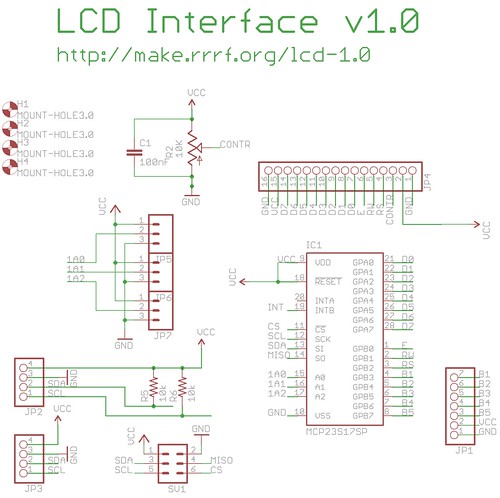 This is a fun board that has some really cool potential. It was primarily designed by Bruce Wattendorf who did the heavy lifting on finding the right chip, prototyping it, and figuring out all the technical details. I hacked on it a bit to get it ready for production with proper silkscreen and such.
This is a fun board that has some really cool potential. It was primarily designed by Bruce Wattendorf who did the heavy lifting on finding the right chip, prototyping it, and figuring out all the technical details. I hacked on it a bit to get it ready for production with proper silkscreen and such.The heart of the board is an MCP23S17 chip made by Microchip. This chip is really cool: it is a 16-bit port expander that you can communicate with via i2c. They also make a nearly-identical one you can talk to via SPI. Our board supports both of those chips. We chose to go with i2c, because it is fewer wires and slightly easier to interface.
The board is designed for the upcoming Sanguino Motherboard which will have matching i2c headers, although you could talk to it with anything that is an i2c master. We only needed 11 pins for the LCD screen, so we've provided the remaining 5 pins as headers for your hacking pleasure. We're planning on making a breakout board with some buttons, or perhaps LEDs. You could easily make your own as well with perfboard.

If you'd like to download the design, its available on SourceForge. We just sent it to the fab today, so it will be at least 10 days until we have prototypes back. Boards and kits will be up on the RRRF store ASAP.
Finally, big thanks to Bruce for his help and contributions. I'd also like to take the opportuntity to point out that this type of collaboration is what the RRRF is for: to help researchers and contributors to the RepRap project see their ideas reach fruition. The RRRF funded the prototypes for this design and might fund yours as well. If you have a design for something that fits with the goals of the RepRap project, please email me at hoeken at rrrf dot org. We don't have funding, so all the money for research comes from sales at the RRRF store if you'd like to support us.
Oh, and here's a video from Bruce:
RepRap I2C LCD test board from Bruce Wattendorf on Vimeo.
The video cut was cut short? What a cliff hanger! Cool none the less ;)
ReplyDeleteawesome!
ReplyDeletethis will come in handy if we ever plan to go standalone (i.e. no pc)
also.. sanguino motherboard? *drool...*
Interesting,
ReplyDeleteThe port-expander chip could also be used to save arduino/anguino pins -- esp. those currently used for sensing the opto end-stop sensors. Esp. since these chips look like these chips can be set up to raise an interrupt output signal when any bit on a port changes state.
-- Larry
Are you really using the MCP23S17 and not the MCP23017? According to the datasheet, the S does SPI, whereas the 0 does I2C. You say you're using I2C...
ReplyDelete...and if I'd read your post a little more closely, I'd have realised you support both. Still, perhaps the clarification will help someone.
ReplyDelete